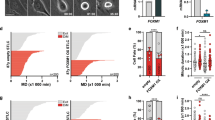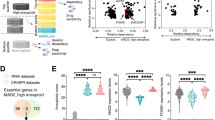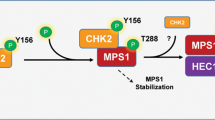Abstract
The mitotic spindle assembly checkpoint ensures proper chromosome segregation during mitosis by inhibiting the onset of anaphase until all kinetochores are attached to the mitotic spindle and tension across the kinetochores is generated. Here, we report that the stable partial downregulation of the spindle checkpoint gene MAD1, which is observed in human cancer, leads to a functional inactivation of the spindle checkpoint resulting in gross aneuploidy. Interestingly, although Mad1 is thought to act as a kinetochore based activator of Mad2 during checkpoint activation, we show that normal levels of Mad2, but not of Mad1, are required for preventing premature sister chromatid separation and for maintaining the timing of an undisturbed mitosis, suggesting a Mad1 independent function of Mad2 that operates independent of its checkpoint function. Most significantly, a partial repression of either MAD1 or MAD2 confers resistance to nocodazole, a drug that inhibits microtubule attachment. In contrast, sensitivity to clinically relevant drugs like taxol or monastrol that inhibit the generation of tension across kinetochores is not modulated by partial downregulation of MAD1, suggesting a functional bifurcation of spindle checkpoint dependent apoptotic pathways.
This is a preview of subscription content, access via your institution
Access options
Subscribe to this journal
Receive 50 print issues and online access
$259.00 per year
only $5.18 per issue
Buy this article
- Purchase on Springer Link
- Instant access to full article PDF
Prices may be subject to local taxes which are calculated during checkout






Similar content being viewed by others
References
Anand S, Penrhyn-Lowe S and Venkitaraman AR . (2003). Cancer Cell, 3, 51–62.
Babu JR, Jeganathan KB, Baker DJ, Wu X, Kang-Decker N and van Deursen JM . (2003). J. Cell Biol., 160, 341–353.
Baker DJ, Jeganathan KB, Cameron JD, Thompson M, Juneja S, Kopecka A, Kumar R, Jenkins RB, de Groen PC, Roche P and van Deursen JM . (2004). Nat. Genet., 36, 744–749.
Bharadwaj R and Yu H . (2004). Oncogene, 23, 2016–2027.
Brummelkamp TR, Bernards R and Agami R . (2002). Science, 296, 550–553.
Cahill DP, Lengauer C, Yu J, Riggins GJ, Willson JK, Markowitz SD, Kinzler KW and Vogelstein B . (1998). Nature, 392, 300–303.
Campbell M and Gorbsky G . (1995). J. Cell Biol., 129, 1195–1204.
Campbell MS, Chan GK and Yen TJ . (2001). J. Cell Sci., 114, 953–963.
Canman JC, Salmon ED and Fang G . (2002). Cell Motil. Cytoskeleton, 52, 61–65.
Chen RH, Brady DM, Smith D, Murray AW and Hardwick KG . (1999). Mol. Biol. Cell, 10, 2607–2618.
Dai W, Wang Q, Liu T, Swamy M, Fang Y, Xie S, Mahmood R, Yang YM, Xu M and Rao CV . (2004). Cancer Res., 64, 440–445.
Ditchfield C, Johnson VL, Tighe A, Ellston R, Haworth C, Johnson T, Mortlock A, Keen N and Taylor SS . (2003). J. Cell Biol., 161, 267–280.
Dobles M, Liberal V, Scott ML, Benezra R and Sorger PK . (2000). Cell, 101, 635–645.
Duesberg P, Li R, Rasnick D, Rausch C, Willer A, Kraemer A, Yerganian G and Hehlmann R . (2000). Cancer Genet. Cytogenet., 119, 83–93.
Fang G . (2002). Mol. Biol. Cell, 13, 755–766.
Fang G, Yu H and Kirschner MW . (1998). Genes Dev., 12, 1871–1883.
Gorbsky GJ, Chen RW and Murray AW . (1998). J. Cell Biol., 141, 1193–1205.
Gurtu V, Kain SR and Zhang G . (1997). Anal. Biochem., 251, 98–102.
Hauf S, Cole RW, LaTerra S, Zimmer C, Schnapp G, Walter R, Heckel A, van Meel J, Rieder CL and Peters JM . (2003). J. Cell Biol., 161, 281–294.
Hernando E, Orlow I, Liberal V, Nohales G, Benezra R and Cordon-Cardo C . (2001). Int. J. Cancer, 95, 223–227.
Herrmann M, Lorenz HM, Voll R, Grunke M, Woith W and Kalden JR . (1994). Nucleic Acids Res., 22, 5506–5507.
Jin DY, Spencer F and Jeang KT . (1998). Cell, 93, 81–91.
Jordan MA and Wilson L . (2004). Nat. Rev. Cancer, 4, 253–265.
Kalitsis P, Earle E, Fowler KJ and Choo KH . (2000). Genes Dev., 14, 2277–2282.
Kasai T, Iwanaga Y, Iha H and Jeang KT . (2002). J. Biol. Chem., 277, 5187–5193.
Kops GJ, Foltz DR and Cleveland DW . (2004). Proc. Natl. Acad. Sci. USA, 101, 8699–8704.
Lengauer C, Kinzler KW and Vogelstein B . (1998). Nature, 396, 643–649.
Lens SM, Wolthuis RM, Klompmaker R, Kauw J, Agami R, Brummelkamp T, Kops G and Medema RH . (2003). EMBO J., 22, 2934–2947.
Li F, Ackermann EJ, Bennett CF, Rothermel AL, Plescia J, Tognin S, Villa A, Marchisio PC and Altieri DC . (1999). Nat. Cell Biol., 1, 461–466.
Li X and Nicklas RB . (1995). Nature, 373, 630–632.
Li Y and Benezra R . (1996). Science, 274, 246–248.
Li Y, Gorbea C, Mahaffey D, Rechsteiner M and Benezra R . (1997). Proc. Natl. Acad. Sci. USA, 94, 12431–12436.
Luo X, Tang Z, Rizo J and Yu H . (2002). Mol. Cell, 9, 59–71.
Martin-Lluesma S, Stucke VM and Nigg EA . (2002). Science, 297, 2267–2270.
Masuda A, Maeno K, Nakagawa T, Saito H and Takahashi T . (2003). Am. J. Pathol., 163, 1109–1116.
Masuda A and Takahashi T . (2002). Oncogene, 21, 6884–6897.
Meraldi P, Draviam VM and Sorger PK . (2004). Dev. Cell, 7, 45–60.
Michel L, Diaz-Rodriguez E, Narayan G, Hernando E, Murty VV and Benezra R . (2004). Proc. Natl. Acad. Sci. USA, 101, 4459–4464.
Michel LS, Liberal V, Chatterjee A, Kirchwegger R, Pasche B, Gerald W, Dobles M, Sorger PK, Murty VV and Benezra R . (2001). Nature, 409, 355–359.
Musacchio A and Hardwick KG . (2002). Nat. Rev. Mol. Cell Biol., 3, 731–741.
Nasmyth K, Peters JM and Uhlmann F . (2000). Science, 288, 1379–1385.
Nomoto S, Haruki N, Takahashi T, Masuda A, Koshikawa T, Fujii Y and Osada H . (1999). Oncogene, 18, 7180–7183.
Peters JM . (2002). Mol. Cell, 9, 931–943.
Rajagopalan H and Lengauer C . (2004). Nature, 432, 338–341.
Rieder C, Cole R, Khodjakov A and Sluder G . (1995). J. Cell Biol., 130, 941–948.
Shah JV and Cleveland DW . (2000). Cell, 103, 997–1000.
Shannon KB, Canman JC and Salmon ED . (2002). Mol. Biol. Cell, 13, 3706–3719.
Shichiri M, Yoshinaga K, Hisatomi H, Sugihara K and Hirata Y . (2002). Cancer Res., 62, 13–17.
Sieber OM, Heinimann K and Tomlinson IP . (2003). Nat. Rev. Cancer, 3, 701–708.
Sironi L, Melixetian M, Faretta M, Prosperini E, Helin K and Musacchio A . (2001). EMBO J., 20, 6371–6382.
Sudakin V, Chan GK and Yen TJ . (2001). J. Cell Biol., 154, 925–936.
Sudo T, Nitta M, Saya H and Ueno NT . (2004). Cancer Res., 64, 2502–2508.
Takahashi T, Haruki N, Nomoto S, Masuda A, Saji S, Osada H and Takahashi T . (1999). Oncogene, 18, 4295–4300.
Tang Z, Bharadwaj R, Li B and Yu H . (2001). Dev. Cell, 1, 227–237.
Taylor S and McKeon F . (1997). Cell, 89, 727–735.
Taylor SS, Scott MI and Holland AJ . (2004). Chromosome Res., 12, 599–616.
Vigneron S, Prieto S, Bernis C, Labbe JC, Castro A and Lorca T . (2004). Mol. Biol. Cell, 15, 4584–4596.
Vogel C, Kienitz A, Hofmann I, Muller R and Bastians H . (2004a). Oncogene, 23, 6845–6853.
Vogel C, Kienitz A, Muller R and Bastians H . (2004b). J. Biol. Chem., 280, 4025–4028.
Wang X, Jin DY, Ng RW, Feng H, Wong YC, Cheung AL and Tsao SW . (2002). Cancer Res., 62, 1662–1668.
Yu H . (2002). Curr. Opin. Cell Biol., 14, 706–714.
Acknowledgements
We thank Tim Yen for generously providing Mad1 antibodies, Bert Vogelstein, Loren Michel and Robert Benezra for providing HCT116 and derivative cell lines and Rene Bernards for the pSuper vector. We are grateful to Irmgard Hofmann for help with the generation of the knockdown cell lines and to Heike Krebber for helpful discussions and critically reading the manuscript. This work was supported by grants from the Deutsche Forschungsgemeinschaft, the Deutsche Krebshilfe and the PE Kempkes Stiftung.
Author information
Authors and Affiliations
Corresponding author
Rights and permissions
About this article
Cite this article
Kienitz, A., Vogel, C., Morales, I. et al. Partial downregulation of MAD1 causes spindle checkpoint inactivation and aneuploidy, but does not confer resistance towards taxol. Oncogene 24, 4301–4310 (2005). https://doi.org/10.1038/sj.onc.1208589
Received:
Revised:
Accepted:
Published:
Issue Date:
DOI: https://doi.org/10.1038/sj.onc.1208589
Keywords
This article is cited by
-
Analysis of matched primary and recurrent BRCA1/2 mutation-associated tumors identifies recurrence-specific drivers
Nature Communications (2022)
-
Mitotic arrest deficient-like 1 is correlated with poor prognosis in small-cell lung cancer after surgical resection
Tumor Biology (2016)
-
A comprehensive analysis of CDC20 overexpression in common malignant tumors from multiple organs: its correlation with tumor grade and stage
Tumor Biology (2016)
-
p31comet inactivates the chemically induced Mad2-dependent spindle assembly checkpoint and leads to resistance to anti-mitotic drugs
SpringerPlus (2013)
-
miR-125b promotes cell death by targeting spindle assembly checkpoint gene MAD1 and modulating mitotic progression
Cell Death & Differentiation (2013)



